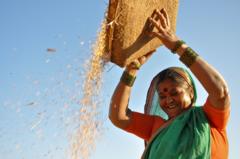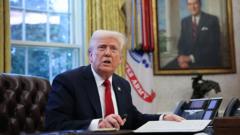India’s agriculture sector, once reliant on foreign aid, has evolved into a self-sufficient powerhouse, but its policies remain a sticking point in US-India trade relations.
**Trump's Push for Indian Corn Imports: Challenges Ahead**

**Trump's Push for Indian Corn Imports: Challenges Ahead**
US Secretary of Commerce criticizes India’s agricultural trade policies amidst ongoing tensions. Experts predict hurdles for US corn exports to India due to protectionist measures and economic disparities.
With the US seeking to increase agricultural exports to India, significant barriers exist, as experts weigh the implications of America's push against India's commitment to protecting its farmers.
India's journey from food scarcity to agricultural surplus has been a remarkable transformation, yet a new challenge arises as US Commerce Secretary Howard Lutnick criticizes the country’s trade policies regarding agricultural imports. At the heart of his concerns lies the question of why India, which has a long history of protecting its agricultural sector, might not purchase US corn.
Lutnick recently pointed out the market restrictions that India imposes on foreign agricultural products, suggesting that limitations should be lifted to allow more access for US farmers. This issue is central in the escalating trade tensions under President Trump, who has labeled India as a “tariff king.” The tariffs, set to take effect on April 2, stand at the forefront of the ongoing exchanges between the two countries.
India's impressive evolution from a food-deficient nation in the mid-20th century to the world's largest milk producer is notable. The agricultural breakthroughs over decades have not only allowed the nation to become self-sufficient but also positioned it as the eighth-largest agricultural exporter globally. India now supplies various products, including grains and dairy, to international markets.
Despite these successes, the Indian agricultural landscape grapples with challenges such as low productivity and inadequate infrastructure. US farmers benefit from larger land holdings—averaging over 46 hectares—compared to Indian farmers, who tend to work under a hectare of land. This has led to a significant discrepancy in productivity, even though agriculture employs nearly half of India's population.
Concerns over high tariffs persist as India maintains an average tariff of 37.7% on US agricultural imports, compared to just 5.3% tariffs levied on Indian goods in the US. In trade relations, India primarily exports products such as rice and shrimp, while the US provides products like almonds and lentils. As the nations negotiate a broader trade deal, the US hopes to secure access to significant agricultural products such as corn and wheat.
Experts stress that pushing for lower tariffs and the introduction of genetically modified crops could severely impact India's smallholder farmers, who would face competition from subsidized foreign goods. The ongoing agitation for better agricultural policies and fair prices reflects the deep-rooted issues within the sector.
With millions reliant on farming for their livelihoods, India must navigate the complexities of trade negotiations. While US interests focus on expanding exports, experts suggest that India should prioritize safeguarding its agricultural economy. Incremental changes—such as investing more in agricultural infrastructure—may be necessary to enhance productivity while maintaining protective policies against foreign imports.
In conclusion, India faces a precarious balancing act as it engages in trade talks with the US. The overarching goal is to reach agreements that protect domestic farmers while still engaging in global trade. Ensuring food security and protecting livelihoods must guide any shifts in policy as India seeks to enhance its position in an increasingly competitive agricultural market. The stakes are high, and the resolution of these trade issues remains to be seen.
India's journey from food scarcity to agricultural surplus has been a remarkable transformation, yet a new challenge arises as US Commerce Secretary Howard Lutnick criticizes the country’s trade policies regarding agricultural imports. At the heart of his concerns lies the question of why India, which has a long history of protecting its agricultural sector, might not purchase US corn.
Lutnick recently pointed out the market restrictions that India imposes on foreign agricultural products, suggesting that limitations should be lifted to allow more access for US farmers. This issue is central in the escalating trade tensions under President Trump, who has labeled India as a “tariff king.” The tariffs, set to take effect on April 2, stand at the forefront of the ongoing exchanges between the two countries.
India's impressive evolution from a food-deficient nation in the mid-20th century to the world's largest milk producer is notable. The agricultural breakthroughs over decades have not only allowed the nation to become self-sufficient but also positioned it as the eighth-largest agricultural exporter globally. India now supplies various products, including grains and dairy, to international markets.
Despite these successes, the Indian agricultural landscape grapples with challenges such as low productivity and inadequate infrastructure. US farmers benefit from larger land holdings—averaging over 46 hectares—compared to Indian farmers, who tend to work under a hectare of land. This has led to a significant discrepancy in productivity, even though agriculture employs nearly half of India's population.
Concerns over high tariffs persist as India maintains an average tariff of 37.7% on US agricultural imports, compared to just 5.3% tariffs levied on Indian goods in the US. In trade relations, India primarily exports products such as rice and shrimp, while the US provides products like almonds and lentils. As the nations negotiate a broader trade deal, the US hopes to secure access to significant agricultural products such as corn and wheat.
Experts stress that pushing for lower tariffs and the introduction of genetically modified crops could severely impact India's smallholder farmers, who would face competition from subsidized foreign goods. The ongoing agitation for better agricultural policies and fair prices reflects the deep-rooted issues within the sector.
With millions reliant on farming for their livelihoods, India must navigate the complexities of trade negotiations. While US interests focus on expanding exports, experts suggest that India should prioritize safeguarding its agricultural economy. Incremental changes—such as investing more in agricultural infrastructure—may be necessary to enhance productivity while maintaining protective policies against foreign imports.
In conclusion, India faces a precarious balancing act as it engages in trade talks with the US. The overarching goal is to reach agreements that protect domestic farmers while still engaging in global trade. Ensuring food security and protecting livelihoods must guide any shifts in policy as India seeks to enhance its position in an increasingly competitive agricultural market. The stakes are high, and the resolution of these trade issues remains to be seen.






















